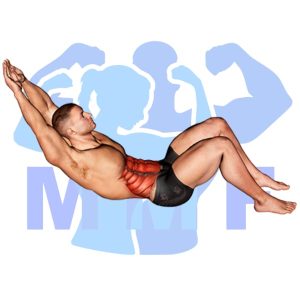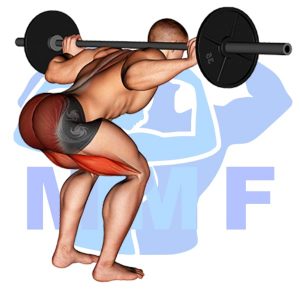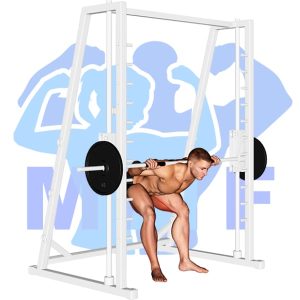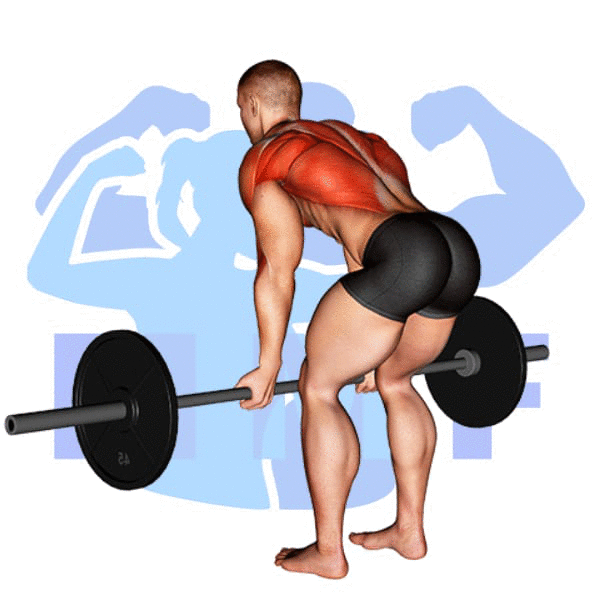Are you tired of feeling frustrated with your midsection? Do traditional ab exercises like crunches and sit-ups just not seem to be cutting it? You may be experiencing a common problem among fitness enthusiasts: weak lower abs. The good news is that there is a solution – the reverse sit up. In this post, we’ll explore the benefits of incorporating reverse sit ups into your workout routine and provide step-by-step instructions on how to perform them properly. Get ready to strengthen and tone those lower abs like never before.
Reverse Sit Up Summary
- Primary Muscles: Iliopsoas (Psoas Major & Iliacus)
- Secondary Muscles: Adductor Brevis, Adductor Longus, Pectineus, Rectus Femoris, Sartorius, and Tensor Fasciae Latte
- Equipment: Body Weight
- Mechanics Type: Isolated
- Force: Pull
- Utility: Auxiliary

Reverse Sit Up Instructions
- Get down on your back in a sit-up position, preferably on a mat.
- Place your hands to the sides for support.
- Raise your legs by flexing your hips while maintaining your knees bent.
- Continue to roll your knees toward shoulders by flexing your core, raising your hips from the mat.
- Return until hips and feet touch the mat.
- Continue the Reverse Sit-Up for 10-20 repetitions.
Video Tutorial
Reverse Sit Up Muscles
Target (Agonist)
- Iliopsoas (Psoas Major & Iliacus)
Synergists
- Adductor Brevis
- Adductor Longus
- Pectineus
- Rectus Femoris
- Sartorius
- Tensor Fasciae Latae
Dynamic Stabilizers
- None
Stabilizers
Antagonist Stabilizers
- None

Benefits of Reverse Sit Up
The Reverse Sit Up exercise is an excellent way to target the iliopsoas (psoas major and iliacus) muscle group. This muscle group is responsible for hip flexion and stabilization of the lumbar spine. Strengthening the iliopsoas can improve your overall posture, reduce back pain, and improve overall performance in any activity involving hip flexion. Additionally, this exercise will help increase core strength and stability, resulting in better balance and coordination. The Reverse Sit Up is a great way to build strength and stability in your iliopsoas muscle group, while also helping to improve your overall fitness level.
Tips for Performing Reverse Sit Up
You’ve landed at the right location if you want to forge ahead your ability to perform reverse sit up. Using these suggestions can enable you to take full advantage of this amazing exercise. You’ll have the ability to develop your core muscles, and reduce your chance of getting hurt. Let’s begin and take a look at how these suggestions will help you.
- Make sure your feet are flat on the ground – This will ensure that you get the most out of the exercise, as it will help you to keep your body in a straight line throughout the entire movement.
- Keep your chest high and your back arched – This will help to activate your core muscles and provide an effective workout for your abs.
- Focus on the contraction at the top of the move – This will help you to really work your abdominal muscles and get the most out of the exercise. Plus, it’ll feel great!
Benefits and Tips Video
Frequent Mistakes To Avoid
Staying away from errors might mean the distinction between a successful workout and an injury when executing reverse sit up. From bad form to not keeping your core engaged, these mistakes can reduce the productiveness of the exercise and can even increase your risk for injury. Not only can avoiding these errors increase your strength, but also can assist in you feeling more assured and inspired when at in the gym. Thus, it is now your turn to maximize your results from this exercise and enjoy the benefits of a successful workout.
- Not engaging their core muscles – Not engaging their core muscles during the exercise can lead to reduced effectiveness and an increased risk of injury.
- Not keeping their feet flat on the floor – Keeping their feet off the ground during the exercise can cause instability, leading to poor form and potential injury.
- Bouncing up and down – Bouncing up and down rather than a slow and controlled movement can put too much strain on the back and neck muscles, leading to muscle soreness or even injury.
Find More Bodyweight Exercises Here
Variations and Complementary Exercises
If you want to add more variety to your workout routine, there are several variations, complementary, and alternative exercises that work similar muscles as the Reverse Sit Up. These exercises can be used as an alternate way to target those same core muscles for a more complete ab workout.
Hanging Knee Up

Hanging Knee Up is a great complementary or alternative exercise for Reverse Sit Up. It is an abdominal exercise that works the same muscles as Reverse Sit Up, but from a different angle. To do this exercise, start by hanging from a bar with your arms extended and your legs bent at 90 degrees. You then raise your knees up to your chest and then lower them back down to the starting position. This exercise works your lower abs, obliques, and hip flexors, making it a great alternative or complementary exercise to Reverse Sit Up.
Hanging Pike

Hanging Pike is a great complementary or alternative exercise to Reverse Sit Ups. It is an exercise that works the core and upper body, while also improving balance and coordination. It requires a pull up bar to be performed properly and requires you to hang from the bar with your arms straight and your feet together. Then you need to lift your legs and torso up into a pike position, making sure to keep your core tight throughout the exercise. Hanging Pike can be a great way to target the same muscles as Reverse Sit Ups, while also challenging the body in different ways.
Hollow Hold

The Hollow Hold is a great complementary or alternative exercise for the Reverse Sit Up. It targets the core muscles in a different way, by requiring the body to maintain a hollow position with the lower back pressed against the floor. To perform a Hollow Hold, the individual lies flat on their back and tucks their chin towards their chest. The arms and legs are then lifted off the ground slightly, while maintaining the hollow position. This exercise is beneficial for strengthening the lower back and abdominal muscles, making it a great alternative or supplement to the Reverse Sit Up.
Check Out These Top Bodyweight Exercises
Hanging Leg Raise

The Hanging Leg Raise is a great alternative or complementary exercise for the Reverse Sit Up. It works the same muscles as the Reverse Sit Up, but in a different way. The Hanging Leg Raise requires you to hang from a bar and raise your legs up and down. This exercise focuses on strengthening your core, including your abs and lower back, while also targeting your hip flexors. It’s a great way to engage more muscles than just those used in the Reverse Sit Up, making it a great addition to any workout routine.
Hands Up Crunch

Hands Up Crunch is a dynamic abdominal exercise that offers an alternative or complementary exercise to the Reverse Sit Up. This exercise starts with the individual lying on their back and bringing their arms up over their chest. They then move into a crunch position, by raising their chest and shoulders off the floor. The individual then returns to the starting position, using their hands to help them up. This exercise engages the core muscles and is a great way to target the upper and lower abdominal muscles. It can also be used as an alternative exercise to the Reverse Sit Up, which targets the same muscle groups but with a different form of resistance.
Crunch

Crunch exercises are a great alternative or complementary exercise to Reverse Sit Ups, as they focus on strengthening the same muscles. A crunch is a simple exercise that can be done anywhere, anytime. It involves lying on the ground with your knees bent, feet flat on the floor, and hands behind your head. To perform a crunch, you must contract your abdominal muscles and curl your torso up towards your knees while keeping your neck in line with your spine. This exercise is great for targeting the abdominal muscles and improving core strength, which will enhance the results of a Reverse Sit Up.
Find More Legs Exercises Here
Opposing Complementary Exercises
To round out the workout, it is beneficial to include exercises that focus on opposing muscle groups. This helps to create balance in the body, allowing for improved posture and overall strength. The following exercises work the opposite muscles as the exercise Reverse Sit Up and should be included as part of a complete workout regimen.
Barbell Good Morning

The Barbell Good Morning is a great complimentary exercise to the Reverse Sit Up. This exercise works the posterior chain muscles, including the glutes, hamstrings, and lower back. It is an excellent way to increase strength and stability in the lower body and also helps with balance. By working the opposing muscle groups, the Barbell Good Morning can help improve the overall performance of the Reverse Sit Up by increasing strength and stability in the lower body, which is crucial for proper form during this exercise.
Good Mornings With Bands

Good Mornings With Bands are an excellent way to complement Reverse Sit Ups, as they target the opposing muscle groups. By performing Good Mornings With Bands, you are working the posterior chain which includes the glutes, hamstrings, and back. This exercise helps to strengthen and stabilize the lower back and core muscles, which are essential for maintaining proper form during Reverse Sit Ups. The resistance from the bands also helps to ensure that your muscles are engaged throughout the entire range of motion. Good Mornings With Bands are a great way to build strength and improve posture while also helping to enhance the benefits of Reverse Sit Ups.
Smith Machine Good Morning Off Pins

The Smith Machine Good Morning Off Pins is the perfect complement to the Reverse Sit Up exercise. This exercise works the opposing muscle group to the Reverse Sit Up, helping to increase flexibility and strength in the lower back, glutes, and hamstrings. The Smith Machine Good Morning Off Pins provides a safe and secure way to perform this exercise. It keeps your spine in a neutral position and allows you to focus on proper form and technique. Additionally, it allows for a greater range of motion, helping to activate more muscle fibers for maximum results.
Reverse Sit-ups: The Ultimate Workout for Your Core!
When it comes to working out, everyone likes to focus on different areas of their body. For many people, the core is a trouble spot that they would like to tone or strengthen. If you fall into this category, reverse sit-ups may be the perfect exercise for you. Not only do they work your core muscles, but they also help to improve your posture and stability. With a little bit of practice, reverse sit-ups can become a powerful addition to your fitness routine and help you reach your goals.
References: Wikipedia | ExRx.net | PubMed.gov | Comprehensive List of Legs Bodyweight Exercises




